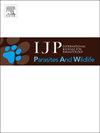Drivers and consequences of nest ectoparasite pressure in tit nestlings
IF 2
3区 医学
Q3 ECOLOGY
International Journal for Parasitology-Parasites and Wildlife
Pub Date : 2025-04-25
DOI:10.1016/j.ijppaw.2025.101075
引用次数: 0
Abstract
Ectoparasites impose significant costs to their hosts and modulate their life-history traits. We evaluated the prevalence and abundance of louse flies, blowflies, fleas and mites in great tits (Parus major) and blue tits (Cyanistes caeruleus) breeding in nest boxes in Central Portugal during two consecutive breeding seasons and assessed: (a) the potential physiological consequences of infestation for nestlings; (b) how nest box re-use and presence of anthropogenic materials in nests affected the ectoparasite abundance; (c) how host reproductive parameters were related to ectoparasitism; and (d) how different nest-dwelling arthropod groups, including ectoparasites, and their diversity correlated. Tit nestlings reared in nests with more blowflies showed symptoms of anaemia, such as lower haemoglobin levels and high erythrocyte maturation index, and tended to grow less. Nestlings from nests with higher number of obligatory parasitic mites had increased polychromasia, and blue tits tended to have lower probability to fledge. Great tit nestlings from nests with fleas also had increased polychromasia compared with those from non-infested nests. Nest box re-use increased the probability of infestation by louse flies and obligatory parasitic mites. In both tit species, broods that were reared later in the season had higher abundance of blowflies and obligatory parasitic mites in their nests. In great tit nests, anthropogenic materials were negatively correlated with flea abundance, and positively correlated with the abundance of Histeridae coleopterans. In great and blue tit nests, obligatory parasitic mites were less abundant when nests showed a higher abundance of Staphylinidae coleopterans and Collembola. Overall, this study shows strong negative effects of nest ectoparasite pressure, particularly blowflies and obligatory parasitic mites, on physiological and fitness measures of hole nesting birds.

山雀雏鸟巢外寄生压力的驱动因素和后果
体外寄生虫对其宿主造成了巨大的代价,并改变了它们的生活史特征。我们评估了在葡萄牙中部连续两个繁殖季节在巢箱中繁殖的大山雀(Parus major)和蓝山雀(Cyanistes caeruleus)中虱蝇、苍蝇、跳蚤和螨虫的流行度和丰度,并评估了:(a)侵染对雏鸟的潜在生理后果;(b)巢箱的重复使用和巢内人为物质的存在如何影响体外寄生虫的丰度;(c)寄主生殖参数与体外寄生的关系;(d)不同的巢栖节肢动物群体,包括外寄生虫,及其多样性是如何相关的。在苍蝇较多的巢中饲养的山雀雏鸟表现出贫血的症状,如血红蛋白水平较低,红细胞成熟指数较高,并且往往生长缓慢。寄生螨数量较多的巢巢的雏鸟多色性增加,而蓝山雀羽化的可能性较低。与没有跳蚤的巢穴相比,来自跳蚤巢穴的大山雀雏鸟的多色性也有所增加。巢箱的重复使用增加了被虱子蝇和寄生螨侵扰的可能性。在这两种山雀中,晚育的巢中有更多的苍蝇和寄生螨。在大山雀巢中,人为物质与蚤类丰度呈负相关,与鞘翅组构类丰度呈正相关。在大山雀和蓝山雀巢中,当巢中有较多的葡萄球菌科和弹线虫时,专性寄生螨的数量较少。总体而言,本研究表明,巢外寄生虫压力,特别是苍蝇和强制性寄生螨,对洞巢鸟的生理和健康指标有很强的负面影响。
本文章由计算机程序翻译,如有差异,请以英文原文为准。
求助全文
约1分钟内获得全文
求助全文
来源期刊

International Journal for Parasitology-Parasites and Wildlife
Medicine-Infectious Diseases
CiteScore
3.80
自引率
5.60%
发文量
113
审稿时长
45 days
期刊介绍:
The International Journal for Parasitology: Parasites and Wildlife (IJP-PAW) publishes the results of original research on parasites of all wildlife, invertebrate and vertebrate. This includes free-ranging, wild populations, as well as captive wildlife, semi-domesticated species (e.g. reindeer) and farmed populations of recently domesticated or wild-captured species (e.g. cultured fishes). Articles on all aspects of wildlife parasitology are welcomed including taxonomy, biodiversity and distribution, ecology and epidemiology, population biology and host-parasite relationships. The impact of parasites on the health and conservation of wildlife is seen as an important area covered by the journal especially the potential role of environmental factors, for example climate. Also important to the journal is ''one health'' and the nature of interactions between wildlife, people and domestic animals, including disease emergence and zoonoses.
 求助内容:
求助内容: 应助结果提醒方式:
应助结果提醒方式:


